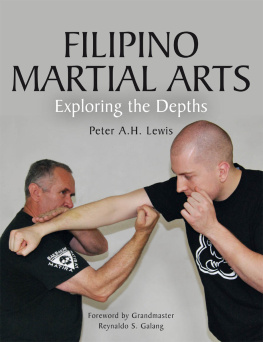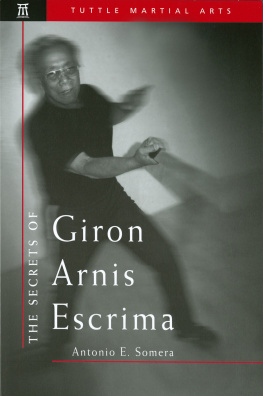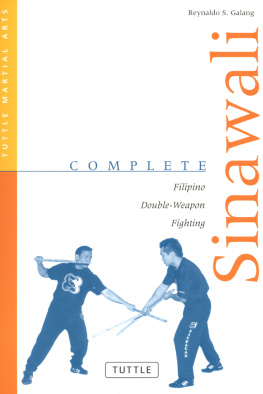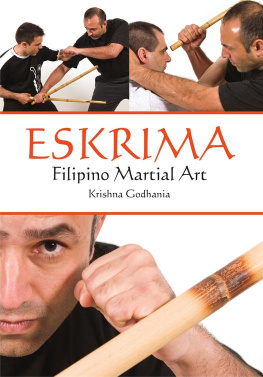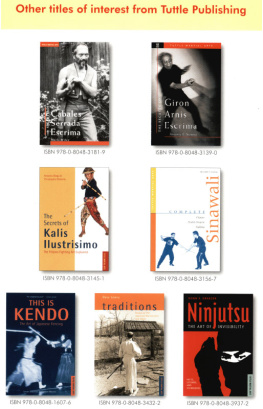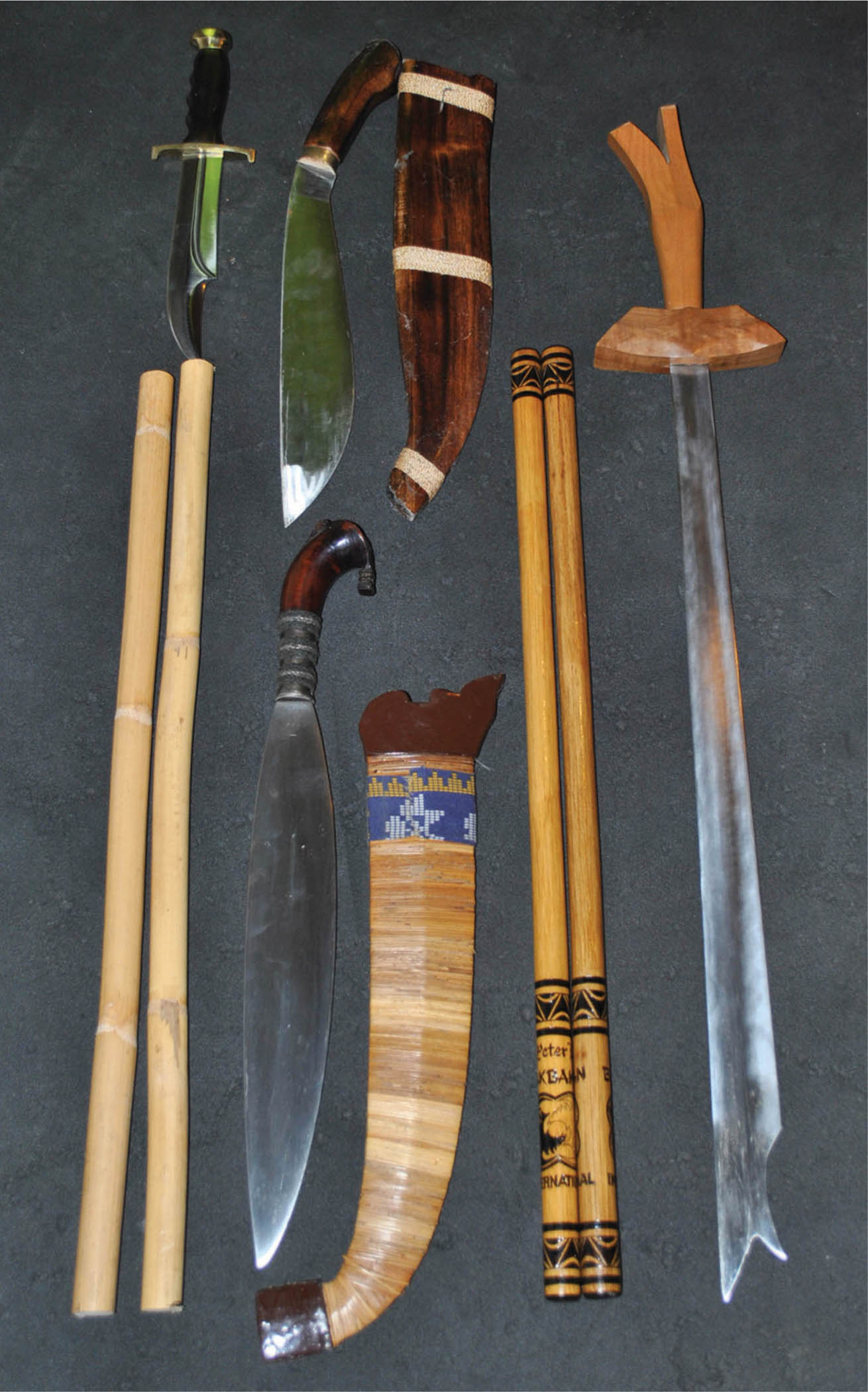
A range of weapons used in the Filipino martial arts.

FILIPINO
MARTIAL ARTS
Exploring the Depths
Peter A.H. Lewis
Foreword by Grandmaster
Reynaldo S. Galang

THE CROWOOD PRESS
First published in 2015 by
The Crowood Press Ltd
Ramsbury, Marlborough
Wiltshire SN8 2HR
www.crowood.com
This e-book first published in 2016
Peter A.H. Lewis 2016
All rights reserved. No part of this publication may be reproduced or transmitted in any form or by any means, electronic or mechanical, including photocopy, recording, or any information storage and retrieval system, without permission in writing from the publishers.
British Library Cataloguing-in-Publication Data
A catalogue record for this book is available from the British Library.
ISBN 978 1 78500 158 1
Disclaimer
The author and publisher of this book are not responsible in any manner whatsoever for any loss, damage, injury or any other adverse consequence of any nature that may result from studying, practising or applying any of the concepts, techniques or ideas and/or from following any information or instructions contained within this publication. The practice of martial arts techniques can be dangerous and too strenuous for some individuals to engage with safely and it is absolutely essential that a doctor be consulted prior to commencing such practice.
Dedication
To my parents Jean and Harry Lewis for the life that you have given to me and for the many years of sacrifice and guidance that have helped me to become a better person. To my teachers in the Filipino martial arts, Grandmaster Epifanio Yuli Romo and Grandmaster Reynaldo Galang for providing my journey with depth, understanding, knowledge and endless enjoyment. To the late Grandmaster Christopher Topher Ricketts, your friendship, guidance and support have enriched my journey greatly and will continually inspire me. To my wife Jenny and daughters, Marisa and Verity, your love and support are a constant source of inspiration to me. To my students who constantly strive to guard the legacy of the art and for being a source of constant motivation.
Acknowledgements
Special thanks to training partners David Hand, Kevin Jones and Audrey Tyler for sharing the journey and keeping me motivated to explore creatively the Filipino martial arts. Deep appreciation to my teacher in the Filipino martial arts, Grandmaster Reynaldo Galang, for your considerable encouragement and support in writing this book. Respectful gratitude to my students, David Hand, Kevin Jones, Audrey Tyler, Jade Tyler and Jamie Orgee for sharing their technical expertise and support in the photographic content of the book. A huge thank you to David Hand and Marisa Lewis for the excellent photographs that are used throughout, with a special acknowledgement to Marisa for taking the cover photos. Finally, sincere appreciation to Kevin Jones, Verity Lewis and Sarah Littlehales for proofreading the manuscript.
CONTENTS
FOREWORD
A more appropriate title could not exist for this book on the Warrior Arts of the Philippines, better known as Filipino Martial Arts (FMA), than Filipino Martial Arts: Exploring the Depths. Known to and embraced only by select and discriminating members of the military, police and combative practices, the Filipino Martial Arts continue to grow in popularity throughout the world.
In aptly heralding the characteristic of this art with this intriguing title, Peter Lewis has indicated the many facets that are the striking peculiarity of this art. FMA is best described as learning characterized not by accumulation, but by accretion. Each layer of technique and knowledge is a contributing and reinforcing variation, application and simplification of past elements learned. As knowledge and experience is amassed, the elements become simpler, more efficient, more natural and instinctive. From mastery of weapons to simple and brutal empty hand applications, FMA develops a distinct persona within the practitioner.
In this book, Peter Lewis takes the reader by the hand and shares the many epiphanies he has encountered in his odyssey through these unique martial arts. Having learned, mastered and analysed the art, Peter unveils the many layered secrets, attributes and riches of this treasure trove known as Filipino Martial Arts.
I am pleased that Peter Lewis has taken the time and effort to write this book to record, preserve, and expose the Filipino Martial Arts as seen through the eyes of a dedicated disciple, practitioner and teacher.
Reynaldo S. Galang
Bakbakan International WHQ
Grandmaster Bakbakan Kali
Canberra, Australia
PREFACE
This book is written with the intention of providing the reader with an opportunity to share in a journey of exploration and discovery of the Filipino martial arts that are generally known as Arnis, Arnis de Mano, Eskrima, Escrima or Kali, among other variants. I hope that it will encourage and inspire creativity, understanding and a deep exploration of techniques, translations and applications regardless of the system practised. The techniques and terminology used as a vehicle for investigation are from the Bakbakan Kali system as taught by Grandmaster Reynaldo Galang. Many techniques will be familiar regardless of the system studied and some may be new, but the overall purpose is to explore personal practices and methods and discover creatively the potential within the Filipino martial arts.
Friends and colleagues within the Filipino martial arts community will appreciate the vast expanse of knowledge available and the endless diversity of potential applications and translations of moves generally first practised with a weapon. It is way beyond the scope of any book to convey the plethora of opportunities contained within our arts and that journey of discovery is ultimately very individual and part of a lifelong pursuit.
The book focuses on two main and fairly generic aspects of the Filipino martial arts. The first section explores the twin weapon aspect widely termed as sinawali and that usually begins with the use of two sticks or doble baston. Consideration is given to fundamental, intermediate and advanced techniques within this category and the evolution of the system to embrace other weapons and devastating empty-hand application. The second section investigates and explores the use of a single stick known as solo baston. A detailed overview of fundamental, intermediate and advanced techniques within this group is provided, together with the identification to translate methods to other weapons classifications or to empty-hand scenarios.
The concluding chapter sets the path to a continued exploration and identifies some opportunities for further study of the Filipino martial arts. The framework of analysis and exploration is expanded to identify the route to ongoing discovery and evolution. I hope that you enjoy your journey within the Filipino martial arts, regardless of the system studied.
Peter Lewis
August 2015
Worcester, England
INTRODUCTION
The Filipino martial arts (FMA) are revered and respected worldwide for the development of a deep understanding of defensive strategies against impact and edged weapons and empty-handed combative attacks. The martial practices of the Philippine archipelago are known by a range of different names, including
Next page
